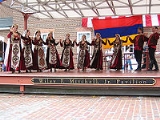
Armenian dance
Encyclopedia
The Armenian dance heritage
has been one of the oldest, richest and most varied in the Near East
. From the fifth to the third millennia B.C., in the higher regions of Armenia
, the land of Ararat
, there are rock paintings of scenes of country dancing. These dance
s were probably accompanied by certain kinds of songs or musical instruments. In the fifth century Moses of Khoren (Movsés Khorenats'i) himself had heard of how the old descendants of Aram
(that is Armenians
) make mention of these things (epic tales) in the ballads for the lyre and their songs and dances.
Traditional dancing is still popular among expatriate Armenians, and has also been very successfully `exported' to international folk dance groups and circle dance groups all over the world. The majority of people feel something special in Armenian dances, and in the passion, subtlety, and eloquence which they embody. All dancers wear the traditional costume to embody the history of their culture and bring their ancestors stories alive. The design of these costumes are influenced by many factors, such as religious traditions, family methods, and practicality. The traditional deep red color and exquisite beading of the costumes brings the dance and the tradition together. The beautiful movements of the Armenian cultural dance are adored by all audience around the world.
Tradition
A tradition is a ritual, belief or object passed down within a society, still maintained in the present, with origins in the past. Common examples include holidays or impractical but socially meaningful clothes , but the idea has also been applied to social norms such as greetings...
has been one of the oldest, richest and most varied in the Near East
Near East
The Near East is a geographical term that covers different countries for geographers, archeologists, and historians, on the one hand, and for political scientists, economists, and journalists, on the other...
. From the fifth to the third millennia B.C., in the higher regions of Armenia
Armenia
Armenia , officially the Republic of Armenia , is a landlocked mountainous country in the Caucasus region of Eurasia...
, the land of Ararat
Mount Ararat
Mount Ararat is a snow-capped, dormant volcanic cone in Turkey. It has two peaks: Greater Ararat and Lesser Ararat .The Ararat massif is about in diameter...
, there are rock paintings of scenes of country dancing. These dance
Dance
Dance is an art form that generally refers to movement of the body, usually rhythmic and to music, used as a form of expression, social interaction or presented in a spiritual or performance setting....
s were probably accompanied by certain kinds of songs or musical instruments. In the fifth century Moses of Khoren (Movsés Khorenats'i) himself had heard of how the old descendants of Aram
Aram
-Bible:* Aram, son of Shem, according to the "Table of Nations" in Genesis 10* Aram-Naharaim , the land in which the city of Haran lay* Aram , an ancient region containing the state of Aram Damascus...
(that is Armenians
Armenians
Armenian people or Armenians are a nation and ethnic group native to the Armenian Highland.The largest concentration is in Armenia having a nearly-homogeneous population with 97.9% or 3,145,354 being ethnic Armenian....
) make mention of these things (epic tales) in the ballads for the lyre and their songs and dances.
Traditional dancing is still popular among expatriate Armenians, and has also been very successfully `exported' to international folk dance groups and circle dance groups all over the world. The majority of people feel something special in Armenian dances, and in the passion, subtlety, and eloquence which they embody. All dancers wear the traditional costume to embody the history of their culture and bring their ancestors stories alive. The design of these costumes are influenced by many factors, such as religious traditions, family methods, and practicality. The traditional deep red color and exquisite beading of the costumes brings the dance and the tradition together. The beautiful movements of the Armenian cultural dance are adored by all audience around the world.
Religious dancing
The origin of religious dancing is ancient, an expression of the inner feelings of the worshipers. It is of interest to note that dance never occurred alone, but was always accompanied with song, clapping of hands, and musical instruments. As with music, so too the dance expressed a person’s internal spiritual emotions and personal disposition. By its very movements dance is able to bring out and make known a person’s grief and joy.See also
- Armenian music
- TamzaraTamzaraTamzara, Tamsara, Tənzərə or Tanzara is an Armenian, Assyrian, Azerbaijani and Greek folk dance native to Anatolia. This dance was especially popular in the regions of Erzincan, Erzurum, Kiğı, Arabkir, Elazığ, and Malatya. There are many versions of Tamzara, with slightly different music and steps,...
- Kochari
- Yarkhushta (Spear Dance)
- Bertpar (Castle Dance)
- Gyond par (Group Dance)
- Harsnapar (Bride Dance)
- Menapar (Single Dance)
- Nazpar (Graceful Dance)
- Sasnapar (Dance of Sasoun region)
- Shirkhani (Group Dance)
- Shurjpar (Group Dance)
- Souserapar (Sword Dance)
- Vagharshapat Dance
- Zuykpar (Double Dance)
- Zeytouni par (Dance of Zeytoun region)
- SirtoSyrtosSyrtos , is the collective name of a group of Greek folk dances. Syrtos, along with its relative kalamatianos, are the most popular dances throughout Greece and are frequently danced by the Greek diaspora worldwide. They are very popular in social gatherings, weddings and religious festivals...
- Uzundara (Bride's dance)
External links
- Clips of authentic Kavaragan Armenian Folk Dances from Historical Armenia: Tamzara, Popouri, Laz Bar, Arapkir Bar, Akheltskha Vart, Govduntsi, Bijou, Kessab Bar, Haleh, Shushan, Suleimanli,Shavali. (Archived 2009-10-25)

